
Albert Laessle (March 28, 1877 – September 4, 1954) was an American sculptor and educator. He taught at the Pennsylvania Academy of the Fine Arts for more than twenty years and is best remembered as an animalier. He won the 1918 Widener Gold Medal.

Albert Laessle (March 28, 1877 – September 4, 1954) was an American sculptor and educator. He taught at the Pennsylvania Academy of the Fine Arts for more than twenty years and is best remembered as an animalier. He won the 1918 Widener Gold Medal.
Albert Laessle was born on March 28, 1877, in Philadelphia, Pennsylvania. His parents immigrated to the United States from Württemberg, Germany. Laessle had an older brother, Henry who was supportive of his artistic ambitions, whereas his parents were not. [1]
Laessle studied art at several institutions: Spring Garden Institute in 1894; Drexel Institute (now Drexel University) 1894–1895, where he studied under Thomas Eakins; and the Pennsylvania Academy of the Fine Arts, where he studied under Thomas Anshutz and Charles Grafly. He spent three years, from 1904 to 1907 in Paris working with Michel Beguine.
In 1907, he returned to Philadelphia and worked in Grafly's studio. [1]
In 1901, he was a contender for a gold medal from the Philadelphia Club for his famous plaster work Turtle and Crab, the turtle was so accurately sculpted, critics alleged it was cast. Laessle did not address the accusations which cost him the medal, but rather retaliated by producing another sculpture of a turtle out of wax which can not be cast, proving he did not cast the first work. [2] [3]
In 1910, he won a medal at the Buenos Aires International Exposition and in 1915, he won a gold medal at the Panama–Pacific International Exposition. [4] In 1916, he won first place in the Americanization Through Art exhibition in Philadelphia.
| External videos | |
|---|---|
 | |
Laessle's sculptures can be found at the Carnegie Institute, the Peabody Institute, the Metropolitan Museum of Art and at the Pennsylvania Academy of the Fine Arts. [4] In Philadelphia's Rittenhouse Square is his famous bronze Billy (1914) – a sculpture of a goat that is known to be a favorite of children who love to sit on it – which was given to the City of Philadelphia by Eli Kirk Price II through the Fairmount Park Art Association (now the Association for Public Art). [5] At the Philadelphia Zoo is his group of bronze Penguins (1917), which was purchased by the Fairmount Park Art Association and installed at the entrance to the zoo's Bird House. Laessle's studio was close to the Philadelphia Zoo, which allowed him easy access to animal models. [6] [4]
Laessle collaborated with Grafly on the General Galusha Pennypacker Memorial for Philadelphia's Logan Circle. Pennypacker had been the youngest Union general in the American Civil War. Grafly's concept was to depict Pennypacker as a bare-chested Roman general astride a chariot-like cannon, and flanked by tigers. Grafly died in 1929, and Laessle completed the memorial, based on Grafly's designs, in 1934. [7]
From 1919 until 1939, Laessle was an instructor at the Pennsylvania Academy. He retired due to a heart condition. [2] In 1951, Laessle won the J. Sanford Saltus Award for Outstanding Achievement in the Art of the Medal from the American Numismatic Society. Among the medals he designed and sculpted during his long career was the Gold Medal of Award for the Sesquicentennial International Exposition held in Philadelphia in 1926. He sculpted America-Abundance, the tenth issue of the Society of Medalists in 1934. In 1927 he was elected into the National Academy of Design as an Associate member and became a full Academician in 1932.

Laessle and his wife Mary had two sons, Dr. Albert Middleton Laessle and Paul Laessle (1908–1988), who was also an artist. [3] Mary died of a stroke in 1944. [2]
He later married Albertine C. De Bempt. [3]
Laessle died in his home in Miami, Florida, on September 4, 1954. [3]
His papers are held at the Archives of American Art. [8]

William Rush was a U.S. neoclassical sculptor from Philadelphia, Pennsylvania. He is considered the first major American sculptor.

Alexander Stirling Calder was an American sculptor and teacher. He was the son of sculptor Alexander Milne Calder and the father of sculptor Alexander (Sandy) Calder. His best-known works are George Washington as President on the Washington Square Arch in New York City, the Swann Memorial Fountain in Philadelphia, and the Leif Eriksson Memorial in Reykjavík, Iceland.

Alexander Milne Calder (MILL-nee) was a Scottish American sculptor best known for the architectural sculpture of Philadelphia City Hall. Both his son, Alexander Stirling Calder, and grandson, Sandy Calder, became significant sculptors in the 20th century.

Charles Allan Grafly, Jr. was an American sculptor, and teacher. Instructor of Sculpture at the Pennsylvania Academy of the Fine Arts for 37 years, his students included Paul Manship, Albin Polasek, and Walker Hancock.

Cyrus Edwin Dallin was an American sculptor best known for his depictions of Native Americans. He created more than 260 works, including the Equestrian Statue of Paul Revere in Boston; the Angel Moroni atop Salt Lake Temple in Salt Lake City; and Appeal to the Great Spirit (1908), at the Museum of Fine Arts, Boston. He was also an accomplished painter and an Olympic archer.
Benjamin Franklin Parkway, commonly abbreviated to Ben Franklin Parkway and colloquially called the Parkway, is a boulevard that runs through the cultural heart of Philadelphia. Named for Benjamin Franklin, a Founding Father, the mile-long Parkway cuts diagonally across the grid plan pattern of Center City's northwest quadrant. It starts at Philadelphia City Hall, curves around Logan Circle, and ends before the Philadelphia Museum of Art.
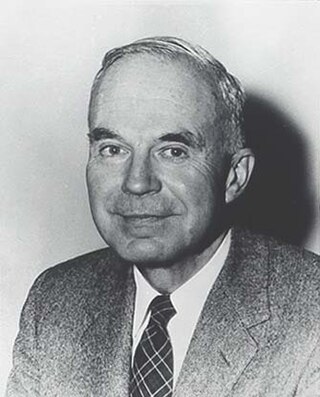
Walker Kirtland Hancock was an American sculptor and teacher. He created notable monumental sculptures, including the Pennsylvania Railroad World War II Memorial (1950–52) at 30th Street Station in Philadelphia, and the World War I Soldiers' Memorial (1936–38) in St. Louis, Missouri. He made major additions to the National Cathedral in Washington, D.C., including Christ in Majesty (1972), the bas relief over the High Altar. Works by him are presently housed at the U.S. Military Academy at West Point, the Library of Congress, the U.S. Supreme Court, and the United States Capitol.
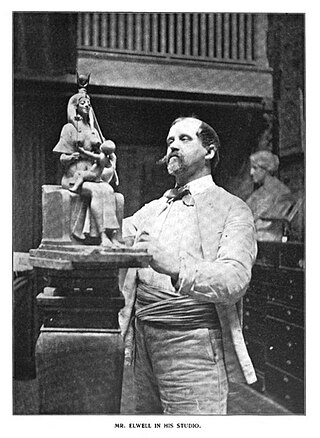
Francis Edwin Elwell was an American sculptor, teacher, and author.

Zenos Frudakis, known as Frudakis, is an American sculptor whose diverse body of work includes monuments, memorials, portrait busts and statues of living and historic individuals, military subjects, sports figures and animal sculpture. Over the past four decades he has sculpted monumental works and over 100 figurative sculptures included within public and private collections throughout the United States and internationally. Frudakis currently lives and works near Philadelphia, and is best known for his sculpture Freedom, which shows a series of figures breaking free from a wall and is installed in downtown Philadelphia. Other notable works are at Arlington National Cemetery in Virginia, Brookgreen Gardens in South Carolina, the National Academy of Design, and the Lotos Club of New York City, the Imperial War Museum in England, the Utsukushi ga-hara Open Air Museum in Japan, and the U.S. Embassy in Pretoria, South Africa.
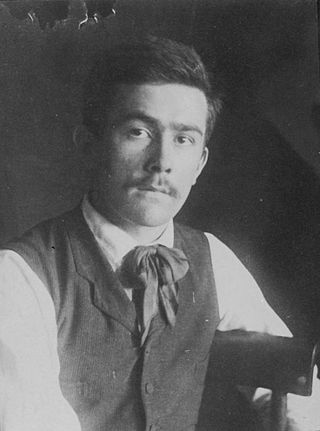
Samuel Aloysius Murray was an American sculptor, educator, and protégé of the painter Thomas Eakins.
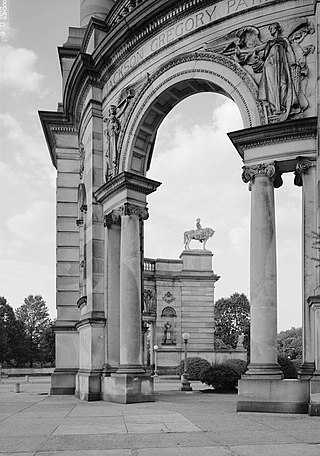
Smith Memorial Arch is an American Civil War monument at South Concourse and Lansdowne Drive in Philadelphia, Pennsylvania. Built on the former grounds of the 1876 Centennial Exposition, it serves as a gateway to West Fairmount Park. The Memorial consists of two colossal columns supported by curving, neo-Baroque arches, and adorned with 13 individual portrait sculptures ; two eagles standing on globes; and architectural reliefs of eight allegorical figures.

Established in 1872 in Philadelphia, the Association for Public Art (aPA), formerly Fairmount Park Art Association, is the first private, nonprofit public art organization dedicated to integrating public art and urban planning in the United States. The association commissions, preserves, promotes, and interprets public art in Philadelphia, and it has contributed to Philadelphia being maintaining of the nation's largest public art collections.

Eli Kirk Price II was a prominent American Philadelphia lawyer, called "the foremost civic and cultural leader in early twentieth-century Philadelphia". He was the commissioner of Fairmount Park during the planning and development of the Benjamin Franklin Parkway, of which he was one of the principal planners. Later, he was instrumental in obtaining funding for the new Philadelphia Museum of Art building and was President of the museum from 1926 to 1933.

John J. Boyle was an American sculptor active in Philadelphia in the last decades of the 19th century, known for his large-scale figurative bronzes in public settings, and, particularly, his portraiture of Native Americans.

Duck Girl is a bronze sculpture by Paul Manship. It is located in Rittenhouse Square near 18th Street and Walnut Street in Philadelphia, Pennsylvania.
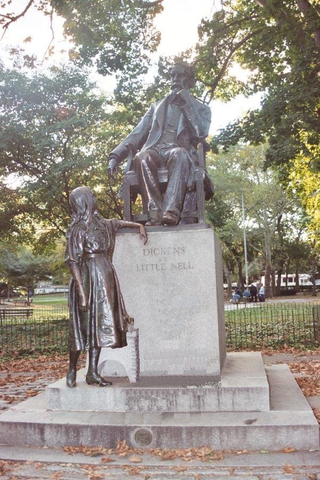
Dickens and Little Nell is a bronze sculpture by Francis Edwin Elwell that stands in Clark Park in the Spruce Hill neighborhood of Philadelphia. The sculpture depicts the 19th-century British author Charles Dickens and Nell Trent, a character from his 1840–41 novel The Old Curiosity Shop. The grouping was one of the most celebrated American sculptural works of the late 19th century.

Walter Elmer Schofield was an American Impressionist landscape and marine painter. Although he never lived in New Hope or Bucks County, Schofield is regarded as one of the Pennsylvania Impressionists.

Clifford Prevost Grayson was an American painter and teacher.

Joseph Thurman Pearson Jr. was an American landscape and portrait painter, and an instructor at the Pennsylvania Academy of the Fine Arts in Philadelphia.

The General Galusha Pennypacker Memorial is a monument in Philadelphia, Pennsylvania, United States. Located in the city's Logan Circle, the monument honors Galusha Pennypacker, a Pennsylvanian who served as a general officer in the Union Army during the American Civil War. Work on the memorial first commenced under sculptor Charles Grafly, though after his death in 1929, work was continued by Albert Laessle, a former student of Grafly, who completed the sculpture in 1934. The overall design for the sculpture depicts Pennypacker in classical dress descending from a stylized cannon that is surrounded by two tigers.
{{cite journal}}: CS1 maint: untitled periodical (link)